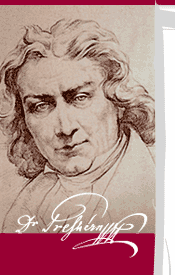| |
|
|
| 1835 |
Life is a prison ... |
|
| |
|
|
 |
he year 1835 was probably one of the
darkest in Prešeren's life. His uncle Jožef, the only
member of his family who had supported him without fail
from his childhood in Kopanje onwards, died. Julija
Primic got engaged, admittedly following her mother's
decision, but she did not show any special feelings towards
the poet either. Prešeren once, at a dance in Kazina,
gave her a notebook containing all the poems he had written
in her honour; she accepted the gift, but rejected him,
telling him "not to get in her way with his love". But
in the middle of the summer, a far greater misfortune
happened. Matija
Čop, his mentor, maybe his only real friend, drowned
in the River Sava near Tomačevo. The sensitive and self-conscious
poet needed Čop at his side, he needed his knowledge and
open-mindedness, his encouragement and direction, and
above all, he needed his understanding. Prešeren's pain
is shown in the elegy he wrote in memory of his friend
in German. The poet Oton Župančič says it is one of the
most beautiful poetic works ever written, but it is somewhat
surprising that Prešeren wrote it in German. Undoubtedly
he wanted to make clear Čop's value and importance to
the Germans of Ljubljana, including the Germanised Slovenes,
who could not or would not understand the Slovene language.
The elegy to Čop, in addition to demonstrating Prešeren's
poetic talent, also confirms his creative power. Prešeren
wrote the long and complex poem in a foreign language
very quickly, in a week, whilst still working at the lawyer's
office, and in addition he was put in charge of recording
Čop's possessions. This was a difficult task as many were
interested in Čop's extensive library and tried to get
their hands on his precious books. Around this time, Prešeren
finally lost his faith in his friendship with Miha
Kastelic, who shamelessly went after Čop's possessions;
in addition, Kastelic's role in dragging the unfortunate
scholar from the Sava has never been fully explained.
Rumour had it that Kastelic offered little help to the
drowning Čop. Prešeren was now increasingly lonely: Andrej
Smole was far from Ljubljana, and he had no other really
good friends; but he was able to count on his drinking
pals and there was never a shortage of those. Čop's death
pushed the poet into the deepest crisis of his life; he
drank too much, neglected his work at the office, completely
failed as the manager of Čop's legacy and, according to
some testimonies, he was even thinking of suicide. Around
this time he wrote the famous poem Kam?
(Where Now?), as well as the beginnings of what is
probably his most important work Krst
pri Savici (The Baptism on the Savica), which was
published in the spring of 1836. This poem is in many
ways so surprisingly unlike Prešeren's other writing that
reviewers and interpreters of his work were quite confused
by it. The poet himself said in a letter to Čelakovsky
that "The Baptism was above all a metrical exercise, to
gain favour with the clergy". This very unusual and controversial
statement still arouses those researching Prešeren's work,
and it points, above all, to the torn and sensitive state
of the poet's spirit under the pressures of everyday life,
which he found harder and harder to endure. We will not
go into a detailed analysis of The Baptism, leaving this
task to modern students of Prešeren.
|
|
| |
|
|
| |
|
|
   |
|
|
|
|


